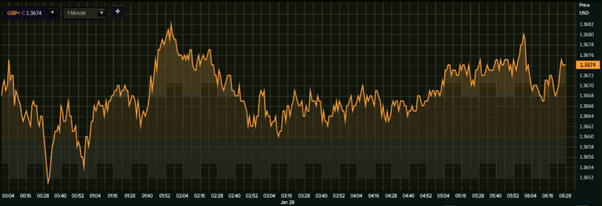UK stock markets are set to open on a negative footing on Thursday, 28 January, tracking the downbeat Asian cues after the Wall Street recorded considerable losses in the previous session. All the major stock indices including the Dow Industrials, S&P 500 and Nasdaq Composite conceded a fall of at least 2 per cent on Wednesday after the US Federal Reserve kept the benchmark funds rate unchanged in a range of 0 to 0.25 per cent.
Global rout in equities
Following the ongoing weakness in the global equities, Japan’s Nikkei 225 and China’s Shanghai Composite ended with a fall of 1.6 per cent, while Hong Kong’s Hang Seng dropped 2.15 per cent at close on Thursday, 28 January.
Extending the losses in the late trade, the Dow Jones Industrial Average (DJIA) ended at 30,303.17, down 633.87, or 2.05 per cent; Nasdaq Composite finished at 13,270.60, down 355.47, or 2.61 per cent, while S&P 500 concluded at 3,750.77, down 98.85, or 2.57 per cent on Wednesday.
London equities had felt the heat of a lower Wall Street opening with FTSE 100 touching a low of 6,505.84, down 2.23 per cent, before terminating 86.64 points, or 1.30 per cent lower at 6,567.37 from the previous close of 6,654.01. The wider share indices including FTSE 250, FTSE 350 and FTSE All-Share ended with a loss between 0.80 and 1.30 per cent on Wednesday.
GBP trips marginally
The sombre mood of the market participants also reflected in the foreign exchange dealings with the Great Britain pound (GBP) sliding marginally against the United States dollar (USD) on Thursday. The GBP to USD pair was trading at 1.3672, down 0.10 per cent from the previous close of 1.3686 at around 0616 GMT.
During the day so far, the currency pair has shuttled between a low and high of 1.3651 and 1.3696 at the interbank foreign exchange market. The Bank of England had fixed a reference exchange rate of 1.3742 USD and 1.1294 EUR against a unit of pound sterling on 26 January.

(Source: Refinitiv, Thomson Reuters)
Federal Reserve maintains rate
The Federal Open Market Committee (FOMC) is aiming to achieve maximum employment with an inflation rate of around 2 per cent in the longer run. The FOMC is likely to maintain an “accommodative stance” of the monetary policy until the Federal Reserve achieves an inflation rate moderately above 2 per cent in the near future, steering an average rate near 2 per cent over time.
The Federal Reserve also reiterated to continue the bond-buying exercise at a rate of $120 billion a month, unaltering the composition of purchases to achieve the designated target of the inflation rate and employment. According to the FOMC, the asset purchases are likely to encourage the ongoing accommodative tightening and smooth market functioning in the near term.
The decline in oil prices in the earlier stretch of the last 12-month period alongside a weaker demand has taken a toll on consumer price inflation, the FOMC noted. The progress in the ongoing vaccination drive and the course of the virus are likely to dictate the path of the economy, it explained.



